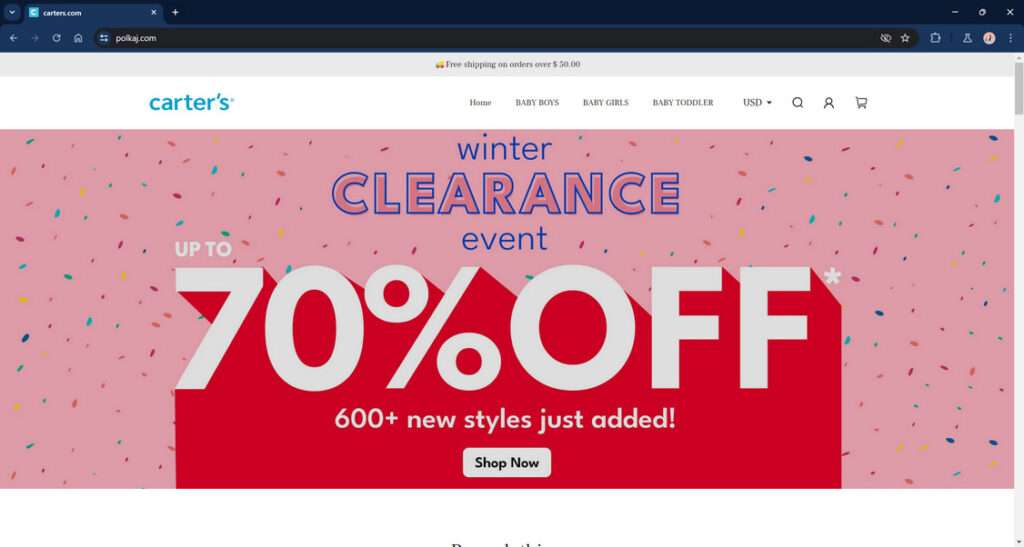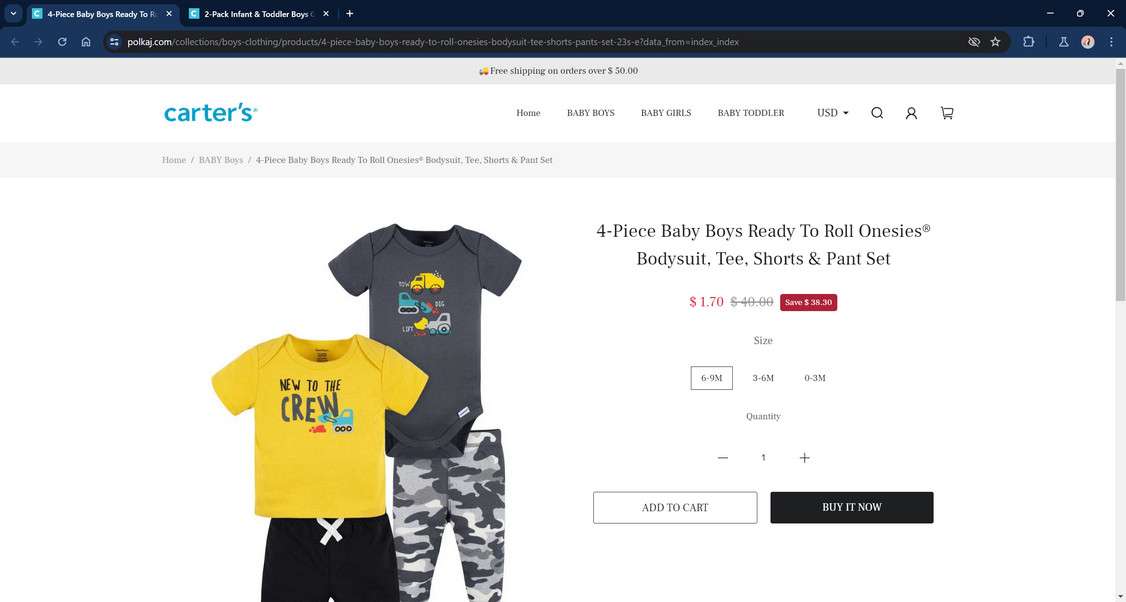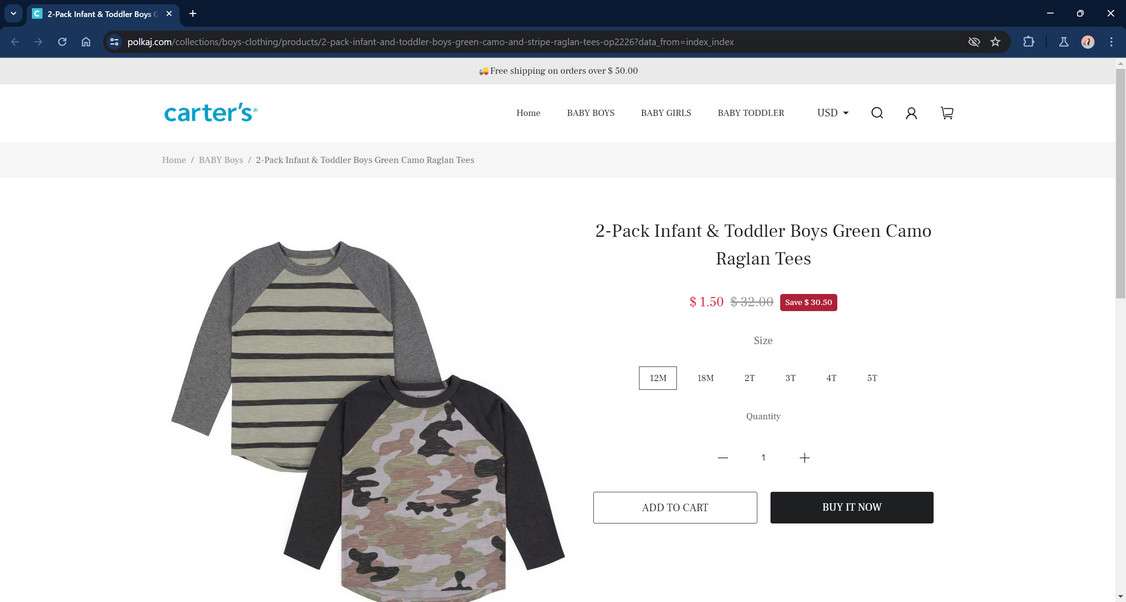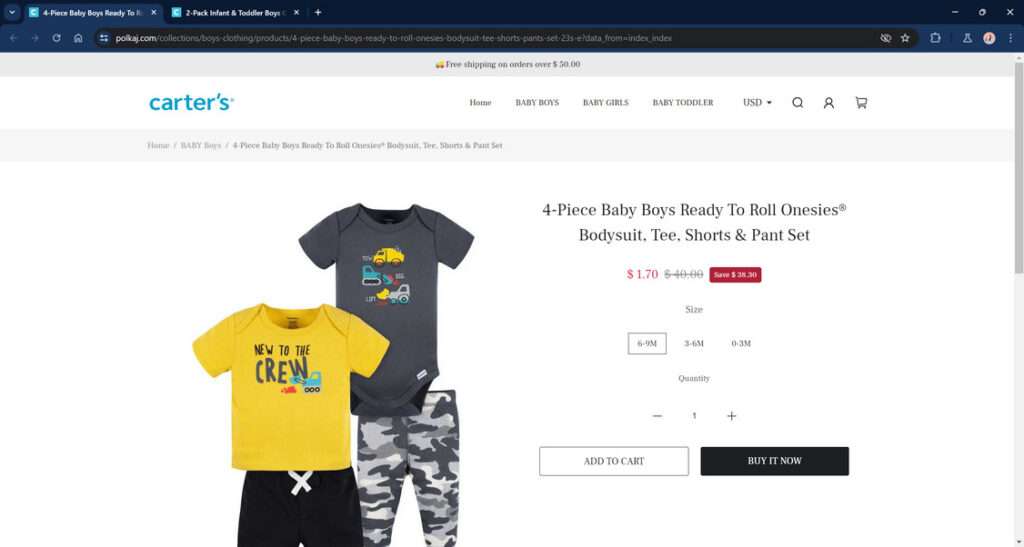Carter’s, a leading brand for baby and kids’ clothing and accessories, has recently become the target of an elaborate online scam. Scammers are creating fake websites, social media pages, and ads that appear to offer Carter’s products for up to 90% off. But unsuspecting shoppers who purchase from these sites receive fake, inferior quality products – or sometimes nothing at all.
This scam has been rampant across Facebook, Instagram, and TikTok. In this comprehensive guide, we’ll break down exactly how the Carter’s scam works, provide tips to identify fraudulent Carter’s pages and websites, and outline steps you should take if you’ve fallen victim to this predatory scheme.



This Article Contains:
Overview of the Carter’s 90% Off Scam
The Carter’s 90% off scam is an online shopping scheme that has exploded in popularity across social media and ecommerce platforms. By promoting fake discounts of up to 90% off all Carter’s merchandise, scammers are able to entice unsuspecting parents and gift-givers into purchasing baby clothes, toys, shoes, and accessories through fraudulent websites and social media pages.
This elaborate ruse is painfully effective thanks to the strong reputation and widespread popularity of the Carter’s brand. Carter’s is one of the largest children’s apparel companies in North America and a go-to option for kids clothing and products. The company sells its products through Carter’s and OshKosh retail stores, legitimate websites like Carters.com, and major retailers like Target, Kohls, and Amazon.
However, scammers are illegally appropriating the highly trusted Carter’s name and logo to create hundreds of convincing fake websites and social media profiles. These imposter sites maintain the look and feel of official Carter’s stores, showcasing all of the company’s most popular products from onesies to playsets. The only difference is everything on the scam sites is listed at 90% off or more.
For example, a 5-pack of Carter’s baby bodysuits that normally costs $27.00 might be shown on a scam website as just $2.99. Such dramatically reduced prices on a reliable brand like Carter’s understandably excites shoppers seeking the best deals on high-quality baby products. But unfortunately, these absurd discounts are only a ploy to pilfer payment and personal information.

The scam capitalizes on three things: the popularity of Carter’s, the tendency of parents to seek bargains on baby items, and the ubiquitousness of social media shopping. Carter’s is one of the most visible and trusted brands in baby apparel with over $3 billion in annual sales. Meanwhile, the average family spends around $12,000 on baby products in the first year alone, so deals are highly sought after. And a study by CPC Strategy found 70% of Millennial moms purchase products through social media ads.
This potent combination allows scammers to target millions of potential victims through carefully designed ads and content. On Instagram, scam accounts with handles like @carters_outlet_shop and @carterscloseouts blitz new parents and gift givers with photos of deeply discounted onesies and shoes. TikTok videos promote the fraudulent sites and claims like “Going out of business!” and “Last chance for 90% off!” ensnare deal seekers.
These ruthless scammers will even mock up fake customer service phone numbers, addresses, and other official details to make their Carter’s imitations seem genuine. But unsuspecting shoppers who purchase from these sites either receive nothing, low-quality knockoffs, or products completely different than advertised. All while the scammers pocket payment info and personal data.
By thoroughly understanding the motivations and techniques behind the Carter’s scam, consumers can recognize red flags that signal fraudulent pages and websites. Being an educated shopper is the best defense against predatory scams seeking to take advantage of Carter’s reputation and parents’ wallets.
How the Carter’s 90% Off Scam Works
The scam artists behind the Carter’s 90% off ruse utilize a number of deceptive tactics to successfully pull off their schemes. By understanding the step-by-step methods used by these scammers, consumers can better identify fraudulent websites, social media pages, and ads.
1. Scammers Set Up Ecommerce Sites and Social Profiles
The first step of the scam is for fraudsters to register domain names like carterswarehouseclearance.com or cartersflashsale.com to create fake ecommerce websites. The sites are designed to precisely mimic the visual design of legitimate Carter’s brand stores, incorporating the company’s fonts, logos, and imagery.
In addition to the sites, scammers create social media accounts on platforms like Facebook, Instagram, and TikTok using Carter’s signifiers and terminology in the usernames. For example, @carters.outlet.store or @cartersclosetclearance. These social accounts allow them to run paid ads directly targeting parents, grandparents, and other shoppers.
To make the scam sites and accounts more convincing, scammers will populate them with stolen product images and descriptions scraped directly from Carter’s official website. They’ll also use messaging like “After Christmas Sale!” or “Store Closing!” to make the discounts seem plausible.
2. Scammers Drive Traffic Through Social Media Ads
Once the scam websites and social profiles are established, the fraudsters shift focus to driving traffic to their online stores through social media ads. These paid ads leverage engagement-building tactics encouraging users to like, comment, share, and visit the fraudulent pages.
On Facebook, scam ads reach parents through their newsfeeds or by appearing in Carter’s official fan groups. Instagram influencers may be paid to post about the fake 90% sales. TikTok ads use urgent messaging around flash sales and limited quantity offers to entice clicks.
3. Shoppers Hooked by Dramatic Discounts
When a potential victim clicks on one of these social media ads, they are taken to the fake ecommerce website or social media page that lists nearly every Carter’s product available at prices slashed by 90% or more.
Seeing a $40 pair of shoes for just $3.99 or a $25 onesie for only $2.99 is incredibly enticing. These dramatic discounts linked to a major brand like Carter’s convince many shoppers they’ve found an unbelievable, but legitimate bargain. Of course, the absurd discounts only exist to trap victims.
4. Scammers Collect Personal and Payment Information
During checkout on the fraudulent websites, unsuspecting shoppers enter sensitive personal information including names, shipping addresses, email addresses, and credit card numbers. All this data goes straight into the hands of scammers to misuse or sell.
Victims may think they are inputting info on a secure checkout form protected by Carter’s or a payment processor like Visa. In reality, the payment forms on scam sites carry no real protections, allowing scammers to immediately access details.
5. Fake Confirmations Finalize the Con
In some cases, the fraudulent sites even go as far as sending fake order confirmation emails made to look like they came from Carter’s or a delivery company. These emails seek to trick victims into thinking their discounted order is being processed and shipped.
Of course, no order is actually placed with Carter’s. And no products will ship. But the confirmation email adds legitimacy to the scam for unsuspecting shoppers.
6. No Products or Inferior Knockoffs Arrive
Ultimately, victims of the Carter’s scam receive nothing for the money spent. Or even worse, they receive clearly inferior counterfeit products worth almost nothing. For example, a victim may receive a flimsy, improperly sized onesie with mismatched Carter’s logos.
Either way, the scammers succeed in stealing personal information and payment details while leaving victims empty-handed. The only way to avoid this outcome is to recognize the red flags and refuse to purchase anything through the fake sites.
How to Identify Carter’s 90% Off Scam Websites
While the creators of these fraudulent websites go to great lengths to replicate official Carter’s branding and sales pages, there are often red flags that can reveal their illegitimacy to savvy shoppers. Here are the top signs to watch out for when assessing a website promoting unbelievable Carter’s discounts:
1. Recently Created Domains
Fraudulent sites tend to have domain registration dates very recently, unlike official businesses like Carter’s that maintain long-standing online domains. Search the ICANN Whois database to find the creation date of any domain you are unsure about. Scam sites often show registration dates within the past 6 months or less.
2. Missing Contact Information
Authentic businesses always provide legitimate contact information like a real phone number, physical address, and customer service email. Scam sites either leave this info totally blank or populate it with clearly fake details. Call the phone number or look up the address to easily vet them. And beware generic email addresses like Gmail or Yahoo rather than official company domains.
3. Implausibly Low Prices
While Carter’s does offer clearance sales frequently, they will never offer blanket 90% off site-wide discounts. If an entire site has prices slashed to $2.99 onesies and $3.99 shoes, it is undoubtedly a scam. Legitimate discounts will be limited to certain products, categories or bundles. Exceedingly low prices are a clear warning.
4. Template Design and Content
Do a quick Google image search on products shown on the website. Scam sites steal product images directly from the official Carter’s site. And website copy/content is usually completely plagiarized as well. No unique product descriptions or details indicate a templated fraud.
5. Enticing but Dubious Slogans
Phrases like “Going out of business”, “Limited time only”, “Store closing sale” or “Clearance event” are commonly used on scam sites despite no genuine relation to Carter’s operational status. These enticing slogans seek to add urgency and tempt shoppers. But any reputable company would not use such misleading language.
Staying vigilant for these telltale signs of scam websites can help parents and other shoppers easily recognize and avoid the rampant Carter’s 90% off frauds. Trust your intuition, do thorough research, and only shop Carter’s through 100% verified channels.
Identifying Carter’s Scams on Social Media
In addition to fraudulent websites, the Carter’s 90% off scam also runs rampant on social platforms using deceitful posts, ads, and accounts. Here are tips for spotting the scam on Facebook, Instagram, and TikTok:
Watch for Facebook ads in your feeds using attention-grabbing slogans about clearance sales, liquidation events, or going out of business with 90%+ discounts. The ads may contain stolen Carter’s imagery and lead to external scam sites.
Also beware fake Carter’s accounts on Facebook promoting the dramatic deals through posts in parenting groups and on their own pages. The accounts tend to be recently created, have generic names (Ex. Carter’s Outlet), and use AI-generated profile images.
Only trust verified accounts with a blue checkmark like the official Carter’s Facebook page. Report any scams to Facebook immediately.
Scam Instagram accounts pretend to be official Carter’s outlets, warehouses or wholesalers promoting huge markdowns on baby clothes and accessories. The posts contain enticing captions and hashtags while using stolen Carter’s product imagery.
Check account creation date and follower count – scams tend to have recently made accounts with low engagement. And view the related website to check for red flags of a fraudulent domain. Don’t trust direct messaging ads about Carter’s closing down either.
TikTok
Like Instagram, scam TikTok accounts pose as Carter’s representatives claiming steep discounts due to store closures or excess inventory. Video ads rapidly promote the fake sales while displaying stolen Carter’s products.
Confirm that any account is the real @carters account with blue check verification before trusting posts about major sales. Beware ads running alongside unrelated content as well. Report suspicious videos and accounts immediately to TikTok.
Staying vigilant on social channels and checking for verification is crucial to avoid this ubiquitous scam. Only shop Carter’s through their official social media pages and ads.
What to Do if You’ve Fallen Victim to the Carter’s Scam
If you placed an order through a scam website or social media page impersonating Carter’s, take these steps right away:
- Contact your credit card company – Report the charges as fraudulent so they can reverse the charges and issue a new card.
- Secure personal information – Change any passwords you entered on fake sites and enable credit monitoring.
- Report fake sites – File complaints with the FTC, IC3, social media channels, etc. to try to get scam pages removed.
- Warn others – Share your experience on neighborhood groups and parenting forums to help prevent others from being duped.
- Monitor your accounts – Keep close watch on your credit and bank accounts for any signs of misuse of your information.
Frequently Asked Questions About the Carter’s 90% Off Scam
1. How does the Carter’s 90% off scam work?
The scam typically works like this:
- Scammers set up fake ecommerce websites and social media accounts designed to look like official Carter’s outlets and sales pages. They steal branding, images, product info from the real Carter’s site.
- Fake ads on Facebook, Instagram, TikTok promote the scam sites and discounts of 90% or more sitewide. Targeting parents, grandparents, and deal seekers.
- Shoppers click on ads and are led to the fraudulent sites where everything seems legitimately 90% off.
- Duped shoppers enter personal and payment info at checkout on the fake sites.
- No products ever ship, or low quality knockoffs arrive instead. The scammers pocket all the stolen details.
2. What are some telltale signs of a fake Carter’s website?
Red flags include:
- Recently registered domain names (within past 6 months)
- Missing or fraudulent contact info and addresses
- Sitewide discounts of 90%+ that are too good to be true
- Plagiarized product images, info, and site copy
- Misleading slogans like “Going out of business”
3. How can I identify Carter’s scams on Instagram?
On Instagram, beware of:
- Accounts with generic names like “@carters_outlet_store”
- Newly created accounts with low followers/engagement
- Posts with stolen Carter’s images and huge discount claims
- Link in bio sends users to an untrustworthy domain
- Limited audience interaction and no blue verification checkmark
4. What are signs of Carter’s scams on TikTok?
TikTok scams to avoid:
- Video ads from accounts pretending to represent Carter’s
- Comments disabled on scam videos (legit sellers encourage engagement)
- Same stolen Carter’s product images used repeatedly
- Links in bios and captions route to sketchy sites
- No blue verfication and limited views/engagement
5. What should I do if I fell for the Carter’s scam?
If you placed an order through a scam website, immediately:
- Contact your credit card company to report fraud
- Monitor your credit and accounts closely for misuse
- Change any passwords you entered on the fake site
- File a report with the FTC and IC3
- Report fake social media accounts to the platforms
6. How can I shop Carter’s real sales safely?
Only shop deals:
- On Carter’s official website, Carters.com
- At Carter’s retail stores
- Through verified Carter’s social media accounts
- And at reputable retailers like Target, Amazon, etc.
Avoid too-good-to-be-true discounts, recently made sites, and unverified ads.
The Bottom Line
The Carter’s 90% off scam preys on the brand’s reputation and parents’ desire to save money. Fortunately, there are warning signs that can help savvy shoppers steer clear of these fraudulent websites and social media pages. Spreading awareness about this scam is key to eventually shutting down these predatory operations.










